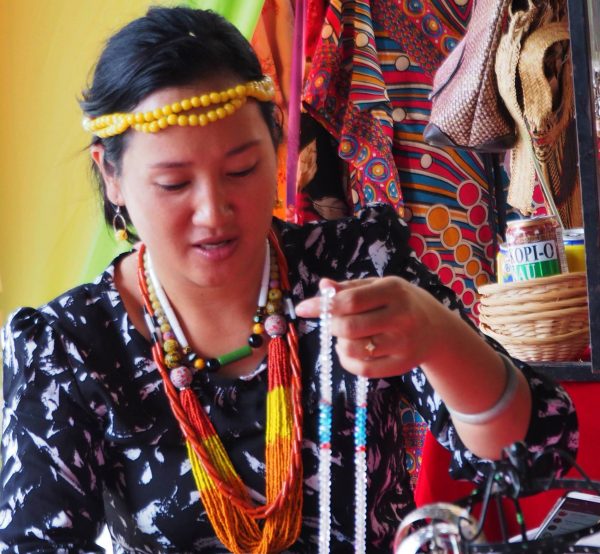
Picture of "Aria" for illustration purposes only.
Aria carefully lifted the lid of the antique heavy brass jewellery box. It was old, rusty and had seen better days, but to her, it was a precious family treasure, but even more precious was the contents of the box. She took out a sparkling multi-strand. Intricately made from intertwined tiny glass beads, the beaded necklace looked as beautiful today as it did when she first laid her eyes on it. Smiling, she closed her eyes and whispered to herself. “The heirloom beads.” A name given to the necklace by her grandmother when she handed it to her years before, and she could still remember the stories her grandmother shared about it.
Beads have been part of the culture of Sarawak’s indigenous groups for generations. But what to many might be seen as mere decorative pieces have in fact a far deeper cultural value amongst these unique communities. Even different tribes have a unique way of adorning themselves with beads.
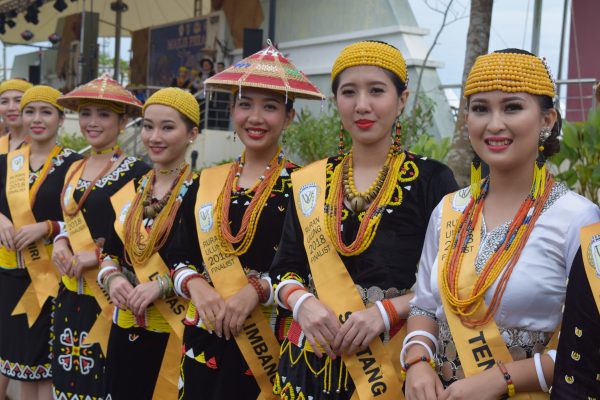
Lun Bawang Beaded Headgear & Necklaces as worn during the Lun Bawang Festival.
Centuries ago, beads were generally made from animal bones and teeth, pebbles, plant seeds and also sea shells. Back then, shamans, otherwise known as the ‘healers’, used them during purification and healing rituals. In fact, they continue to do so today.
Sarawak was introduced to beads via tradesmen from as far as China, India and the Middle East who used them as a sort of currency when bartering for goods. In those days, the beads were mostly made of glass and ceramic, and were considered luxury items, sought after by society’s aristocrats. They were regarded as a symbol of status, so much so that the lower classes of some ethnic groups were rarely seen or even allowed to wear them. Sadly, it is now difficult to find the antique beads because traditionally, upon death, the deceased were buried along with their beads, as a gift for them to use in their journey to the next world.
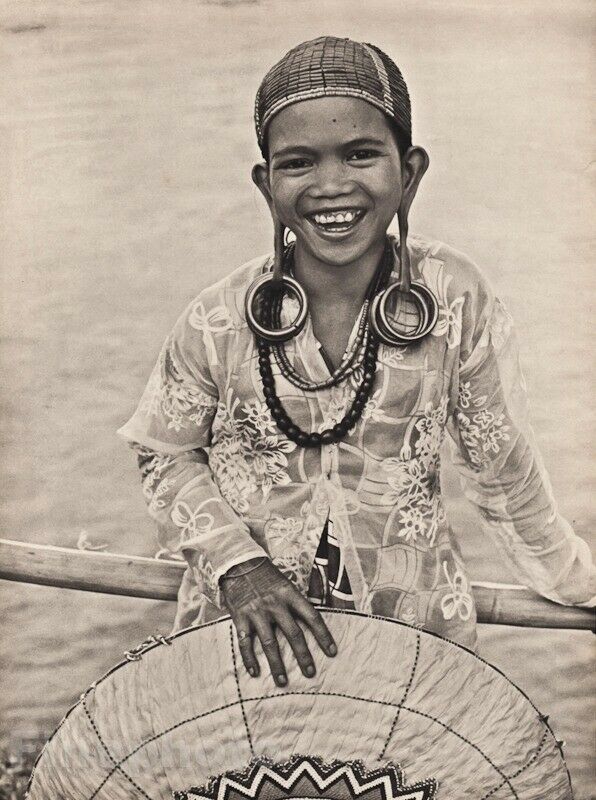
Photo Credit: https://www.ebay.com/itm/1940-Vintage-BORNEO-CHILD-GIRL-Jewelry-Beads-Fashion-Sarawak-Photo-Art-K-F-WONG-/193309179247
Because of their value, beads were precious possessions, carefully looked after and only to be used during special ceremonies such as marriages, religious events or traditional festivals like Hari Gawai, the annual harvest festival celebration. Just like the story of Aria’s beaded necklace, those beads that weren’t buried with their owners, were passed down from one generation to the next often with an interesting tale of how they came to belong to the family, making them a treasured part of the family for generations to come.
Although beads are still used as decorative items and ornaments, many modern versions are now sold as souvenirs. And over the years they have become chic and fashionable art pieces worn by today’s youth.
At the forefront of the preservation of this ancient art and taking advantage of this new trend are the talented women of the Long Tuma village in Lawas, Northern Sarawak who continue to make ceramic beads which helps to keep the tradition alive while generating income for their community and at the same time, ensuring the younger generation appreciate its significance. Even now, they take the trouble of digging up smooth fine clay, found near the crocodile-infested Pa’ Lawas river. The clay goes through an elaborate process of being pounded, kneaded and shaped into tiny beads before being sun-dried and fired in a backyard bonfire.
Apart from ceramic beads like the ones from Lawas, other common bead materials are ‘kabo’, glass, crystal, pearls, glass, wood, plastic, acrylic, and metal. Energy beads, which are semi-precious stones, are believed to have healing powers to assist the wearer physically, emotionally and spiritually.

Roselyn Lah from Livan Handicraft showcasing how to make a Kayan style beaded necklace.
Photo Credit: http://travelandbe.com/learning-to-bead-with-an-award-winning-community-activist-kayan-in-kuching-sarawak/
Are you inspired by the legacy of the Borneo beads? Then it’s time to make your very own Sarawak jewellery! Create your own designs – whether you want a classically vintage, or chic and snazzy – the choice is yours, just follow our tutorial.
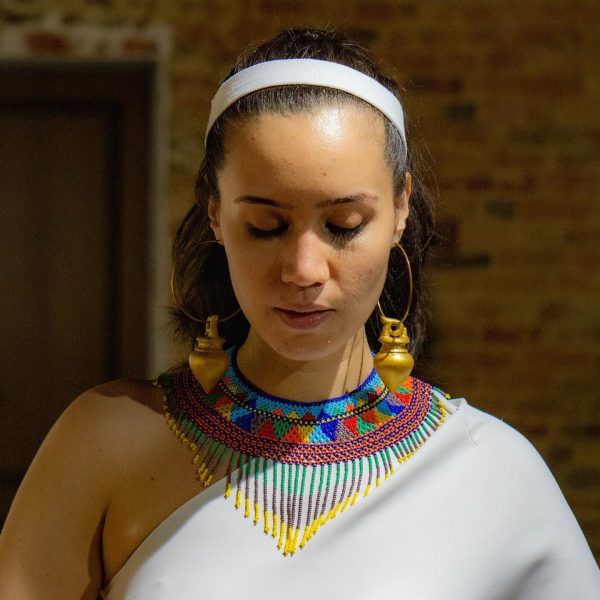
The ever so gorgeous Alena Murang donning a contemporary style beaded necklace.
Photo Credit: https://www.facebook.com/alenamurang
You need the following tools (see below for where to buy equipment) before you start your DIY jewellery beading project. First of all, get yourself a good pair (or more!) of jewellery pliers. These are smaller and finer typed pliers with a smooth finish inside the nose area, making them more suitable for use during the beading process. It makes sense to learn the different types of pliers because each one of them serves a different purpose. Some of the basic ones include round-nose, flat-nose, needle-nose, chain-nose (yes, I am still talking about pliers!), crimping pliers and wire or side cutters.
Next, make sure you have beading needles, beading cord/thread and beading wires. You will also need other essentials such as bails (for pendants), clasps, connectors, crimps, ear wires, split rings and an assortment of headpins and eye pins. Also, make sure you have a bead organiser that is able to hold a variety of your beads. This way, it is much easier to organise them based on their shapes, colours and sizes. Finally, get your ruler or tape measure out, and it is time for you to get started!
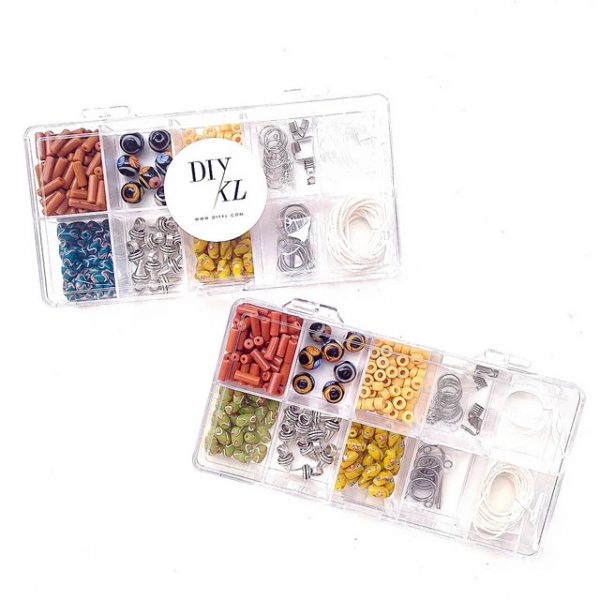
A Lun Bawang Borneo Beads Deluxe Kit by DIY KL.
You need a certain amount of patience when beading but the finished article is worth it!
For starters, let me share how you can make your very own beaded earrings:
Items needed:
- Beads (you can use a few small or large beads, or mix them up)
- 2 headpins
- 2 ear wires
- Needle-nose pliers
- Regular pliers
- Wire-cutter
Method:
- String the desired pattern of beads onto the headpin. Use regular pliers (place it a little bit above the beads) and bend the wire to a 90-degree angle.
- Use needle-nose pliers to bend the wire back the other way, also to a 90-degree angle, so that it makes a hook shape.
- Next, with the needle-nose pliers, bend the wire down to a further 90-degree angle to make a loop.
- Use the needle-nose pliers to hold the flat part of the loop, and use regular pliers to wrap the wire 3 times around to ensure it is secure. Cut off the remaining wire.
- Take your ear wire, open it up, hook it on to the loop, and close it back.
- Repeat the same step for the other earring, and there you have it, your DIY beaded earrings!
Where do you get these beading supplies? In Kuching, a one-stop centre for your beading supplies is Beads Story by Xing Ya Enterprise in Kota Sentosa (https://www.facebook.com/xingyabs/). Another spot to visit is the Fabric Accessories House (https://www.facebook.com/FAH-749751455036648/), which has several outlets in the city, but the most-visited one is located at 17-18, Gambier Street. Other places include Satex Textiles & Accessories and SL Flowers and Handicraft Shop. You may also find beading supplies in most handicraft/arts & craft stores.
Local handicraft makers, for example Raben Beads, have also turned to online business as a means of expanding their target audience, so now you are able to get your beading supplies at the click of a button!
The intricate process of beadmaking makes every bead all the more unique in its own special way, and is undoubtedly valued and appreciated as a form of Borneo legacy. Wear your DIY bead masterpieces and share photos of them with us. Happy beading!
Meanwhile don’t forget to take advantage of the ‘Sia Sitok Sarawak’ campaign. Sarawakians and non-Sarawakians residing in Sarawak can enjoy discounts of up to 50% comprising of over 30 travel attractions in Kuching, Sibu, Mukah, Bintulu, Miri and Mulu. The campaign runs until 15 November 2020, for travels up to 31 December 2020. If you wish to know more about Sarawak’s rich heritage, here are some interesting travel packages for you to enjoy: Kuching Heritage Walk, Fuzhou Heritage Trail, and Mukah: The Melanau Heartland. For more information, visit https://sarawak.travel/explore-all.
Before you start your travels, please take the necessary precautionary measures and complete an e-health declaration form a minimum of 12 hours before your entry into Sarawak. Click here for further details.